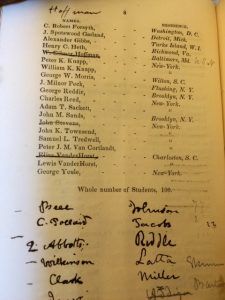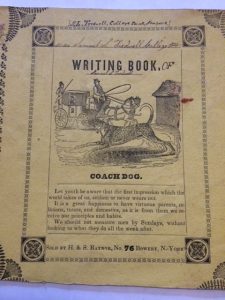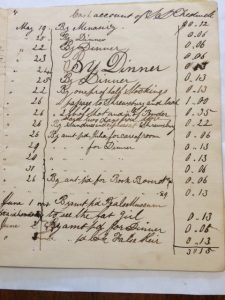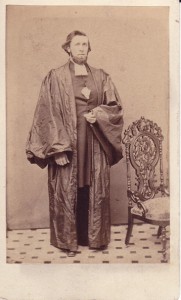Samuel Tredwell’s School Days
by Ann Haddad
Back-to-School!
September was a busy month for Eliza Tredwell. After spending summer vacation at the family farm in Rumson, New Jersey, this mother of seven children (ranging in age from 3 to 17), returned to the city and faced the task of back-to-school shopping. Like today’s mothers who endure long lines at Staples, Mrs. Tredwell likely dealt with the crowds at such shops as H. & S. Raynor, on the Bowery, and C. Shepard & Co., on Fulton Street, to buy ledgers, notebooks, and writing instruments for her children’s school work. She also may have patronized clothing stores such as Brooks Brothers or Lord and Taylor’s, on Catherine Street, to outfit the children for the school year.
Boarding School for Samuel
What made 1838 different was that her 11-year-old son, Samuel Lenox (1827-1917), was enrolled in boarding school for the first time. Leaving home at a young age to attend school was not unusual, for in the early 19th century, most schools of higher education enrolled students between the ages of 12 and 15.
On October 1, 1838, Samuel began his first year at St. Paul’s College and Grammar School, located over six miles from Manhattan in College Point, on 100 acres along the shore of Long Island Sound (now part of Queens). In the Introductory Class, he counted among his 31 classmates members of the Van Cortlandt, Morris, Jones, and other distinguished New York families.
As he would be living away from home for the entire school year, Samuel’s shopping list was longer than those of his sisters, who attended day schools. As stipulated by St. Paul’s, his necessities included sufficient clothing, at least half a dozen towels, hair brushes, and other toiletries. On Sundays and religious feast days he was required to wear a uniform dress suit:
“a single breasted round jacket, with a rolling collar and black worsted buttons,
of dark blue cloth, pantaloons, and a black silk vest.”
In addition, Samuel needed a bible and a prayer book, both stamped with his name.
The Respected Founder
Founded in 1835 by Dr. William Augustus Muhlenberg (1796-1877), St Paul’s College and Grammar School had as its objective “the intellectual and moral education of Boys, in accordance with the principles of the Protestant Episcopal Church.” An early “Church-School” scholastic model that combined a classical education with the tenets of Christianity, it sought to provide both academic rigor and moral lessons, while emphasizing the familial nature of the school.
Daily chapel was an important part of the school day, as was the study of Scripture; from these practices standards were set that would lead to the development of Christian character. Dr. Muhlenberg, upon being asked, “What kind of boys do you want?” replied:
“Give us such boys as have been blessed with the instructions of a pious mother.”
.
The Cost of an Education
Seabury Tredwell paid a yearly tuition of $300 for his son’s education at St. Paul’s. The school year ran from the first week of October through the first week of August. The cost included all classes (except for music and drawing), and room and board. After paying an optional fee of $7 per year for the care of a physician who resided at the school, it must have reassured the Tredwells to learn that:
“It is a remarkable fact that since its opening…not a pupil has died, or contracted a fatal illness on the premises.”
On to “College”
After spending three years in the Grammar School, where he studied mathematics, English, and writing, Samuel matriculated at age 14 to the College. When his use of the term “College” was called into question, Dr. Muhlenberg, responded:
“Whenever our senior boys know less of Latin, Greek, or Mathematics,
than the majority of the A.B.s in the US, we shall begin to think
there is some arrogance in calling our school St. Paul’s College.”
The curriculum, taught by distinguished professors and clergymen (among whom was Reverend Samuel Seabury, the son of Seabury Tredwell’s namesake), included Greek and Latin classics, mathematics, Scripture studies, French and English literature; and, (unusual for the time), physics, geology, chemistry, and anatomy. The skills of elocution and recitation were also highly valued and emphasized in the daily studies. Corporal punishment was forbidden; monthly reports of the students’ progress, including marks for “disorder,” were sent home to parents. Viewed as a superb and progressive school in its time, St. Paul’s saw many of its graduates go on to esteemed colleges.
St. Paul’s also offered a “Mercantile Studies” program, in which students took courses such as Merchandise and Commerce, Laws of Trade, Statistical and Commercial Geography, and Bookkeeping. For reasons unknown to us, Samuel did not choose this program.
All Work and No Play Makes Samuel a Dull Boy
The daily schedule at St. Paul’s was long and regimented, but three hours of every day were set aside for recreation. Saturdays were devoted to play and to the welcoming of visitors.
Situated on an idyllic peninsula, the campus of St. Paul’s was ideally situated for outdoor sports. The boys enjoyed rowing and swimming in a cove immediately in front of the school, as well as ice skating, gardening, and riding. Several religious festival days, including the Epiphany and St. Paul’s Day, were celebrated with the cancellation of classes, and with “huge” cakes and other sweets provided by parents.
Samuel’s 1843 cash book paints an amusing picture of the school life and antics of a 16-year-old boy. Among his purchases that year were boots, an accordion, fishing tackle, a lock of “false hair,” and entry to “Peal’s Museum to see the fat girl.” Samuel must have broken the school rules when he paid 31 cents for a dog named Nip, only to pay Charly 6 cents to take care of Nip for one day! And, on at least one occasion, he broke the rule that forbade visits home to parents, when he traveled by boat to Rumson and back.
On the last few pages of the same cash book may be found Samuel’s awkward attempts at romantic poetry, along with this line scrawled in the margin:
“Poetry is the way to the heart of a woman.”
Life after St. Paul’s
Due to lack of sufficient endowment funds, the New York State legislature repeatedly denied St. Paul’s College a collegiate charter, which in effect forbade the school from granting degrees. In 1846, after 11 years of service to the school, Dr. Muhlenberg resigned his position to become rector of the Church of the Holy Communion in New York City. Despite their best efforts, the lack of funds forced the administrators to close the school in 1850. The buildings and land were sold to a private developer.
We don’t know what Samuel thought of the education he received at St. Paul’s College. Did he find the experience memorable? How did it impact his life and the choices he made? At least one former student seemed to recall the school with fondness. Thomas Kelah Wharton (1814-1862), wrote in his diary many years later:
“I passed some 8 years of my life in the pleasant seclusion of scholastic
pursuits. What a change! The revered Professors gone! The Muses’ haunt,
the marble porch where Wisdom went to talk with Socrates or Tully, hears
no more, save the hoarse dissonance of jarring wheels.”
Sometime after 1843, Samuel Tredwell left the school. According to city directories, by 1845, at age 18, he was back home on 4th Street, working as a commercial merchant on Front Street. On December 13 of that year, he began a four-year law clerkship with his brother-in-law, Effingham Nichols, an attorney in New York City, while simultaneously continuing as a commercial merchant and, in 1847, as a distiller on Water Street. The law must not have been Samuel’s cup of tea, for in December 1848, he took over his cousin’s crockery business at 195 Pearl Street, an enterprise he owned until 1854. Samuel had followed in his father’s footsteps after all, literally walking down the same street, to become a merchant.
Sources
- An Account of the Grammar School, or Junior Department, of St. Paul’s College. New York: F.C. Gutierrez, 1842. New York Historical Society Library.
- Ayres, Anne. The Life and Work of William Augustus Muhlenberg. New York: T. Whittaker, 1889. Accessed September 8, 2016. www.anglicanhistory.org.
- Cash Book, S.L.Tredwell, College Point, N.Y., 1843. Merchant’s House Museum Archives. 2002.4602.27 Box 3.
- Catalogue of the professors, instructors, and students of St. Paul’s College and Grammar School, for the session of 1839-40; together with the act of incorporation, constitution of the college, board of visitors, course of studies, discipline, &c. and observations addressed to parents intending to place their sons in the institution. College Point, N.Y. : [s.n.], 1840. New York Historical Society Library.
- Doggett’s New-York City Directory. New York: John Doggett, Jr. 1846-1854. New York Historical Society Library.
- Hunt, Thomas C. and James C. Carper, eds. The Praeger Handbook of Faith-Based Schools in the United States, K-12, Volume 1. Santa Barbara, CA: ABC-CLIO, LLC, 2012.
- Journal of Saint Paul’s College, Feb., 1844, Vol 1, no. 1, College Point, NY: Charles R. Lincoln, 1844. New York Historical Society Library.
- Manuscripts and Archives Division, The New York Public Library. “College Point in 1839” New York Public Library Digital Collections.1854. Accessed September 7, 2016. http://digitalcollections.nypl.org/items/ecfc2630-e5fd-0132-978d-58d385a7bbd0.
- Writing Book, S.L. Tredwell, College Point, NY, 1843. Merchant’s House Museum Archives. 2002.4602.28 Box 3.









Great informative article! Educational opportunities were certainly much more plentiful in New York than California during the first half of the 19th century. Several of the more prominent citizens here in SLO County (on California’s Central Coast) were educated in the east, including Robert Edgar Jack, who clerked at an NYC firm then fought briefly with the Union army near Gettysburg before heading west to make his fortune in California.
Love the reference to “Tom Brown’s School Days.”
Eva Ulz
Curator & Director
History Center of San Luis Obispo County
Thanks, Eva! I’m so glad you enjoyed the post, AND that you got the title reference!!
Dear Ann: Thank you for a wonderful article! Each year, my students and I study Victorian manners and customs in conjunction with our reading of the novel, “Washington Square.” We then visit the Merchant’s House Museum. I’m sure my students will enjoy hearing about your account of Samuel Tredwell’s school days! Thank you so much for sharing this info! Sincerely, Sam Ramirez (English Teacher, Saint George Academy, New York City) 9/15/16
I’m glad you enjoyed the article, Mr. Ramirez, and that you find it useful for your students. Stay tuned for further blogs gleaned from the Tredwell archives!
Times change! Fortunately no school today would find it impressive that nine of their students had died or contracted a fatal illness. They’d be more likely to brag about their diverse student population. Not one of St. Paul’s strengths.
Dear Ms. Knapp,
I bought copy of your wonderful book, “An Old Merchants House..” during one of our school visits to the museum. I’d love to have you autograph my book. I bring my students for a group tour of the Merchants House each fall and your book is a wonderful addition to our lessons in Victorian manners and customs. Perhaps I can drop the book off at the museum to have you autograph it. Or perhaps I can send you a little book label to sign (that I can paste into the book). Thanks again for sharing your wonderful knowledge of the Victorian era with us. Wishing you happiness and continued blessings. Sincerely, Sam Ramirez (English Teacher/ St. George Academy/ New York City/ 9/23/16
Perhaps the Common Core of the time. The more I remember my disinterest in Latin, the more I wonder what saver school would have had me in the mid-19th century.
This is an excellent and accurate account of Muhlenberg’s famous school at College Point, upon which many if not most great American schools were built; well researched, and written with great style. There is no need to adjudicate Muhlenberg’s concerns from a 21st-century perch. In fact, Muhlenberg’s scholastic model was very progressive in its day and thus was a stepping tone to our current views about many important things. Thank you very much! cp
Thank you so much! I’m glad that Samuel’s father had a progressive view of education for his son. The daughters’ education, however, was very much in keeping with the times. Stay tuned for my September post!
I shall look forward to that. cp
[…] – Mrs. Okill’s and Mrs. Gibson’s. [For a discussion of private school education for boys, click here to read “Samuel Tredwell’s School Days,” September, […]